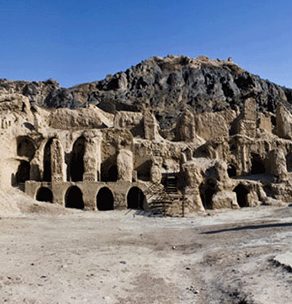In the province of Sistan and Baluchistan, there is an ancient area called Shahr-e Sukhteh, on the side of the road from Zabul to Zahedan. This city is thousands of years old and is considered one of the wonders of ancient Iranian history, which has been registered in the list of national heritage and UNESCO.
Shahr-e Sukhteh is one of the oldest cities that experienced the first traces of urban civilization in the eastern half of Iran. In fact, this ancient city-state was one of the first places where people decided to settle. This city had the most advanced culture and civilizations in its time that generally covers more than 280 hectares.
According to the research, the Shahr-e Sukhteh of Zabul is more than 5 thousand years old. People have lived in this city between 3,200 and 1,800 BC with urban civilization. This means that more than 1,400 years of life have been going on in this city. In fact, the civilization discovered in the Shahr-e Sukhteh is on the same level as the civilization of Jiroft and the Bronze Age. This city was built on the banks of the Hirmand River and Hamon Lake, which was the main reason for the decision to settle the people together.
In general, the life of the Shahr-e Sukhteh is divided into four separate periods, including the foundation of the city, growth and prosperity, the beginning of decline and finally destruction. This city was originally founded by civilized people interested in industry and progress, in the vicinity of a roaring river. A short time later, he witnessed the development of his civilization and industry. The development and prosperity of the city lasted for about 300 years. After that, when the Hirmand river changed its course and many enemies attacked this city, the period of decline began until it was completely isolated and destroyed.
The remaining works show that this city with an area of more than 280 hectares was divided into 5 parts that include residential areas, central areas, industrial areas, monuments and cemeteries. Residential areas were concentrated in the east and east of the city, the industrial sector was in the northwest, and monuments and cemeteries were in the southwest. The urban civilization in this area was so advanced that they built the industrial sector at a certain distance from the city, so that the residential areas are further away.
Shahr-e Sukhteh is one of the richest ancient monuments of Iran, which is one of the most popular sights of Sistan and Baluchistan, next to Chabahar port. Although due to the hot and dry climate of Sistan and Baluchistan, not much attention is paid to this valuable work, but the secrets of the Shahr-e Sukhteh alone can surprise anyone. After visiting the valuable treasures of this city, we will find out about the rich civilization that took place in this city more than 4,800 years ago.
Artificial eye: The Shahr-e Sukhteh had one of the most modern civilizations, so that medical science also spent one of its most advanced periods in this city. Years ago, a woman’s body was found in this city with a dark ball in her left eye. On this orb there was a circle in the shape of the pupil of the eye and thin lines of gold wire in the form of capillaries on the white of the eye. The research of specialists and archaeologists attributed this orb to an artificial eye. This orb is still perfectly intact after thousands of years. It is considered to be made of natural bitumen and a mixture of animal fat. According to researchers, this artificial eye is the first artificial eye in the world, which is more than 3 thousand years old. They believe that the artificial eye of Shahr-e Sukhteh belongs to a woman of about 30 years old. This eye was placed in place of his left eye with two leather straps. The artificial eye is now kept in a museum in the southeast of Zahedan.
Brain surgery in the Shahr-e Sukhteh: The wonders of the secrets of the Shahr-e Sukhteh are endless. Another of the most amazing medical discoveries in this city is the world’s first cranial surgery. A skull was found in this city with traces of a triangular split on its right side. Researchers attribute it to a brain surgery that was performed on a 12-13-year-old girl in ancient times. The marks left on the skull show that this surgery was done to remove the fluid accumulated in the brain. Although the 13-year-old girl died a few months after the surgery.
Shahr-e Sukhteh Cemetery: More than 50 years ago, a grave was accidentally discovered in Shahr-e Sukhteh, and after that, a large cemetery in this area was unveiled by archaeologists and experts. The graves in this cemetery were all made of raw clay. But there are differences in the shape and size of the graves. According to the researchers, these differences are not related to gender or age, but to the social class of people and their religious beliefs. Pottery and dishes were also found in these graves. These dishes were buried in the grave along with the corpses of people, which was rooted in the beliefs of the ancient people. The higher the social class, the more and more expensive dishes and pottery were placed next to the corpse.
Ruler: A high-precision ruler was discovered in this city, which is another secret of the Shahr-e Sukhteh. This ruler is about 10 cm long and half a millimeter accurate, which is an amazing figure for more than 4000 years ago. This ruler is made of ebony wood. This ruler shows the advanced civilization and industry of 5000 years ago in this city
Backgammon: According to experts, the backgammon found in this city is the oldest backgammon in the world. It is even older than the backgammon found in the Ur royal cemetery in Mesopotamia. This backgammon board was found in grave number 761 along with a clay container containing 60 marbles. This board is made of ebony wood and has a rectangular shape. On it, a design of a snake can be seen, which is wrapped around itself 20 times and finally has its tail in its mouth. The beads of this backgammon board are made of common stones at that time, including lapis lazuli, antique and turquoise.
Animation: The world’s first animation was also discovered in this area and surprised the world. This animation is actually the role of a goat on a clay cup that jumps in 5 movements and feeds from a branch. This clay cup was found in a 5,000-year-old grave. By examining the purposeful repetition of this amazing design, archaeologists found that the artist who created this design intended to display a purposeful movement. This design is considered the first animation in history.
Jewelry making: Like most arts, jewelry making was popular in the Shahr-e Sukhteh. Jewelry has been found in this city, which shows that people used to make beautiful necklaces and decorative jewelry from precious metals such as gold and stones such as antique, marble, lapis lazuli, turquoise, etc. The stones and metals used in this jewelry became more expensive depending on the social class of the people. These jewels have often been found in Shahr-e Sukhteh cemeteries, indicating that the individual’s jewels were buried with the body.
Water pipes: Another of the most amazing secrets of the Shahr-e Sukhteh is the discovery of water and sewage pipes. Remains of water and sewage piping using clay pipes can still be seen in this city. The pipes are buried in the walls and underground, and a few meters away, there is a pipe leading out, which was probably a sewer pipe.
Other discoveries of this ancient region include pottery with the signature of a potter, hammers, needles, women’s combs and hairpins, shoes and belts, all kinds of seeds such as melon seeds, legumes, dried fish, rice, pottery kilns, and metal melting furnaces. did Also, the industry of shoemaking, weaving, etc. has been prevalent in this city, as traces of fabrics and leather accessories such as shoes, belts, etc. have been discovered in this city.
Shahr-e Sukhteh is the name given to this city by a British soldier. After visiting this city during the Qajar period, this agent called this city Shahr-e Sukhteh in his diary for the first time. Because he had seen traces of a large amount of ash piled around the city and thus concluded that a big fire had probably occurred in this city. If this was not the case and the ashes dumped around the city were the only ashes remaining from the many industrial furnaces that were working in this industrial city.
Others believe that this city was burned twice. Once at the beginning of development and once again at the beginning of decline and destruction, in fact, one of the main reasons for the destruction of this city is that it was set on fire. For this reason, this city became known as the Shahr-e Sukhteh.




